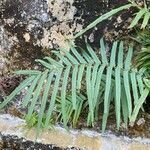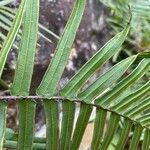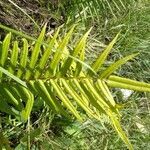Rhizome shortly decumbent, closely branched, up to 7 mm in diam., with crowded stipe bases and scales; scales ferruginous to stramineous, subulate to narrowly lanceolate, up to 8 x 1.4 mm, entire. Fronds caespitose, erect to arching, up to 1.7 m long, up to 8 per plant. Stipe firm, stramineous, proximally adaxially flattened, sulcate distally, up to 470 mm long, up to 6 mm in diam., proximally densely set with stramineous scales. Lamina elliptic-oblong, up to 1.2 m x 300 mm, 1-pinnate, with up to 60 free pinna pairs. Rachis stramineous, adaxially sulcate, closely set with stramineous pluricellular hairs up to 0.3 mm long. Pinnae sessile, alternate, reduced towards base, linear-attenuate, up to 140 x 9 mm, base inequilateral, acroscopically broadly cuneate to cordate, serrate, adaxially sparsely set with 3-5-celled hairs up to 0.3 mm long, abaxially closely set with 3-5-celled hairs up to 0.4 mm long along the costa and veins; costa adaxially shallowly sulcate, pronounced abaxially; venation evident, forked once or twice, free in sterile fronds. Sori linear, continuous along a marginal vascular commissure extending from near base to near pinna apex; receptacle paraphysate. Indusium brown, linear, up to 0.7 mm wide, repand.
Plants (20-)30-100(-150) cm tall. Rhizome erect, short and robust, 2-2.5 cm in diam., woody, apex densely clothed with yellow-brown scales. Fronds clustered; stipe firm, dark straw-colored or light brown, 10-30 cm or larger, 3-4 mm in diam., densely scaly when young, scales like those of rhizome, sparse; rachis straw-colored, sparsely scaly; lamina 1-pinnate, oblanceolate-oblong in outline, 20-90 × 5-25 cm or larger; lateral pinnae up to 40 pairs, alternate or sometimes subopposite; lower pinnae 3-4 cm apart, decumbent, sessile, not connate with rachises, progressively shorter toward base, basal pair auriculiform, middle pinnae longest, narrowly linear, 6-15 × 0.5-1 cm, base slightly expanded and cordate, both sides slightly auriculiform, upper ones larger and overlapping rachis; pinnae 1-1.5 cm apart, sterile margin minutely and evenly serrate, not cartilaginous, apex acuminate; midvein prominent abaxially and light straw-colored; veins slender, contiguous, oblique, simple or forked; terminal pinna similar to lateral pinnae in shape. Lamina pale green, opaque, thinly leathery, glabrous.
Stems stout, short-creeping, densely scaly; scales pale brown. Leaves clustered, 1--10 dm. Petiole green to pale brown, 1--30 cm, densely scaly; scales dense proximally, extending to and along rachis. Blade oblanceolate, 1-pinnate, (15--)25--50(--80) × (6--)13--25 cm; rachis not winged. Pinnae numerous, separated proximally, closely spaced to barely overlapping distally, not remaining green through winter, not decurrent on rachis, not articulate to rachis, linear-lanceolate to linear-attenuate, simple, 2--18 cm × 4--9 mm; base asymmetrically cordate to widened or truncate; margins serrulate, prominently so near apex; apex acuminate, attenuate, or acute; scales of rachis grading into uniseriate hairs on abaxial costae, or hairs absent on abaxial costae; proximal pinnae not divided or lobed. Veins free, forked. Sori narrow, blade tissue exposed abaxially. 2 n = 116.
Terrestrial or lithophytic ferns. Rhizome short-creeping; scales numerous, conspicuous, c. 5 mm long, narrowly triangular, pale brown. Fronds monomorphic, arching, appearing to radiate from a crown. Stipe usually c. 2–25 cm long, pale brown, grooved, scaly towards base. Lamina 1-pinnate, oblong-obovate, c. 15–80 cm long, c. 5–30 cm wide. Pinnae closely spaced, to 25 cm long, narrowly oblong and tapering above, decreasing in length from apex to base, most pinnae attached by midrib only; base subcordate, ± overlying rachis; margins finely serrate in sterile zones. Lowermost pinnae very much shorter, deltoid to cordate; terminal pinna usually the longest; veins free, at ± 90° to costa, simple or once-forked. Paraphyses abundant.
Rhizome creeping, up to 8 mm in diameter, set with linear-lanceolate, attenuate, pale brown rhizome-scales. Fronds spaced up to 10 mm apart, erect to arching, firmly membraneous; Stipe pale brown, terete, up to 120 mm long, glabrous except for numerous scales similar to rhizome-scales basally; lamina elliptic-oblong, up to 1.2 x 0.4 m, simply pinnate, tapering towards base; pinnae linear-attenuate, up to 160 x 14 mm, glabrous, sterile margins minutely crenate, lower pinnae petiolate, the upper sessile; veins free; rhachis sulcate, pale brown, glabrous. Sori in submarginal lines extending for most of the length of the fertile pinnae; indusium membranous, subentire.
Terrestrial or epilithic. Rhizome short, prostrate to semi-erect. Fronds tufted, erect to arching, uniformly pinnate, basal pinnae gradually reduced, lamina narrowly elliptic to oblanceolate, 200-1150 x 80-400 mm, monomorphic, glabrous; pinnae linear-oblanceolate, narrowly attenuate, margins serrulate. Sporangia in linear, marginal, continuous sori with entire indusium.
Rhizomatous perennial. Fronds arching, stipe proximally scaled, lamina elliptic-oblong, 1-pinnate, pinnae linear-attenuate, margins minutely crenate. Null Sori in submarginal lines extending for most of pinna length, indusium subentire.
Rhizome creeping, set with pale brown rhizome scales. Upper pinnae simple (not pinnatifid), lower pinnae all simple, gradually reduced. Pinnae linear-attenuate. Sori in submarginal lines extending for most of length of fertile pinnae.




